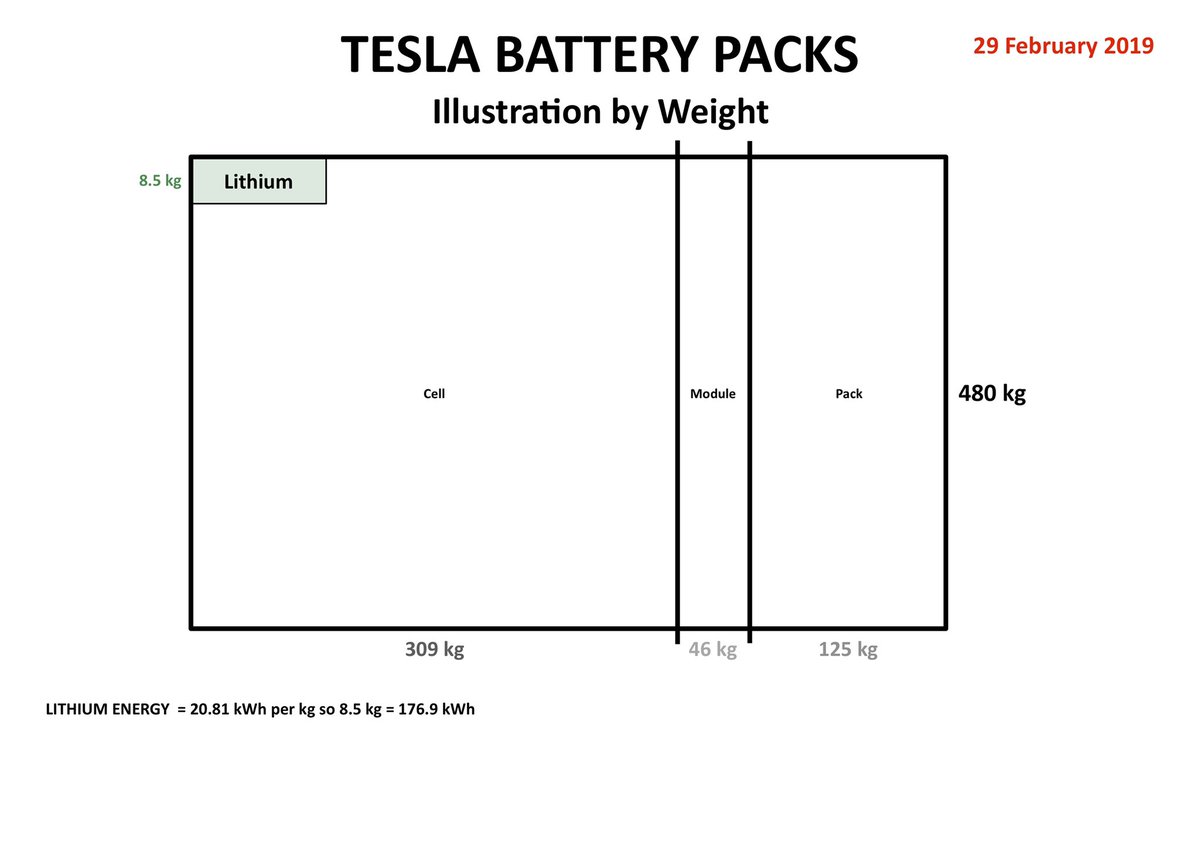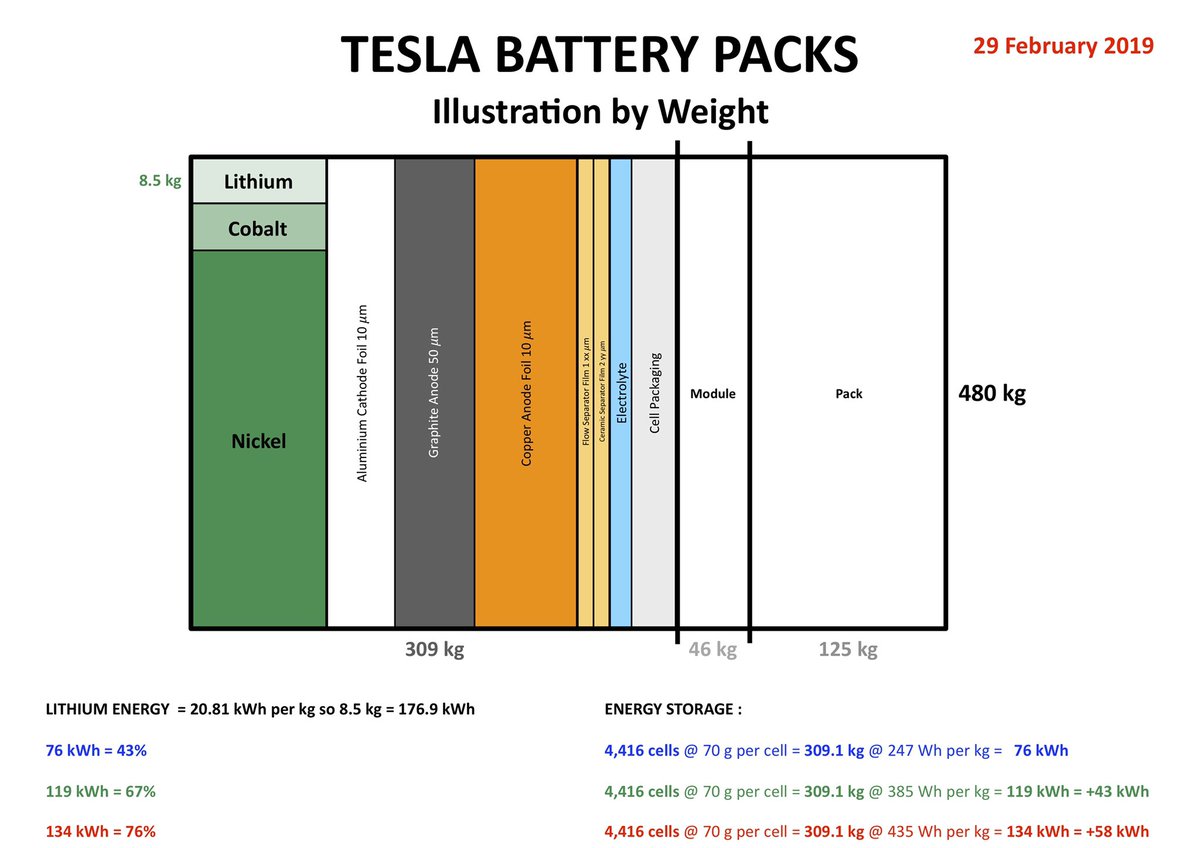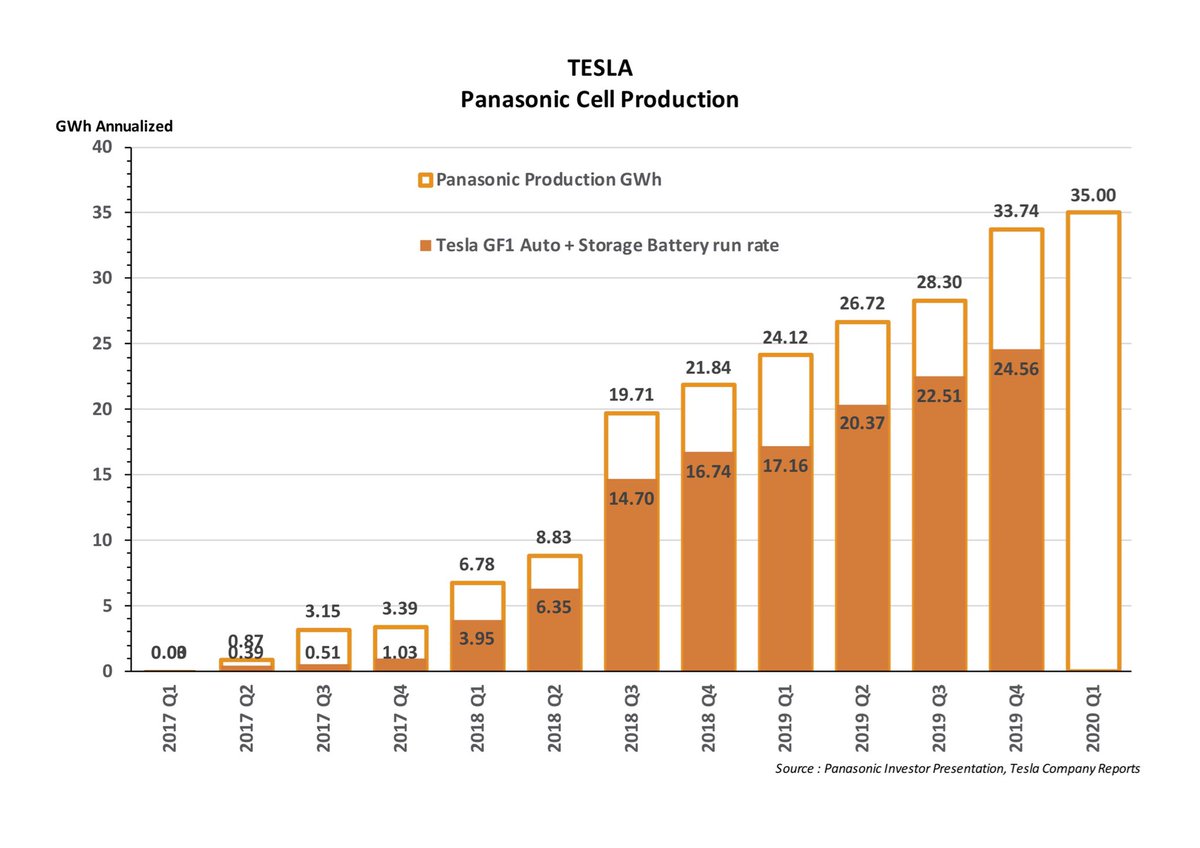A PRIMER FOR BATTERY DAY
This is a lengthy thread
- so get some popcorn and settle down to a relaxing read
- the punch lines are many all the way through to the end
This is not an attempt to predict all of Battery Day
- it is just a primer on one aspect - SIZE
@elonmusk
This is a lengthy thread
- so get some popcorn and settle down to a relaxing read
- the punch lines are many all the way through to the end
This is not an attempt to predict all of Battery Day
- it is just a primer on one aspect - SIZE
@elonmusk
Let us assume that this is in fact a Roadrunner cell
What is its size ?
- some say it is 54 mm diameter x 99 mm length or “5499”
For illustration purposes I am going to assume that it is 55 mm diameter x 90 mm length or “5590”
Length is both a critical factor and constraint
What is its size ?
- some say it is 54 mm diameter x 99 mm length or “5499”
For illustration purposes I am going to assume that it is 55 mm diameter x 90 mm length or “5590”
Length is both a critical factor and constraint
The constraint that I am applying here is the height limitation of the existing Model 3 and Y Battery Packs
- which I am assuming to have an overall height of 105 mm and a module height of 90 mm
- which I am assuming to have an overall height of 105 mm and a module height of 90 mm
With a physical size of 5590 I estimate each cell to weigh around 0.618 kg or 1.36 lb
That’s a serious piece of Bologna Sausage
Staying with a total cell weight of 309 kg that translates to 500 cells in a pack instead of 4,416 cells
That’s a serious piece of Bologna Sausage
Staying with a total cell weight of 309 kg that translates to 500 cells in a pack instead of 4,416 cells
Just using “illustrative” numbers and not trying for precision but just directional importance :
2170 profile : 4,416 cells at 70 g each = 309 kg
5590 profile : 500 cells at 618 g each = 309 kg
2170 profile : 4,416 cells at 70 g each = 309 kg
5590 profile : 500 cells at 618 g each = 309 kg
Fewer cells should result in less inactive packaging materials and less electrical connecting materials with more of the weight being given to the active materials
So even without chemistry changes we can expect a bump in total energy stored
Perhaps from 76 kWh to say 80~85 kWh
So even without chemistry changes we can expect a bump in total energy stored
Perhaps from 76 kWh to say 80~85 kWh
Now remember that we have stretched the height to 90 mm versus 70 mm
90 mm / 70 mm = +28.6%
This means more of the physical volume goes into the length rather than into the area
So the horizontal footprint is smaller because more of the volume of the battery is in the length
90 mm / 70 mm = +28.6%
This means more of the physical volume goes into the length rather than into the area
So the horizontal footprint is smaller because more of the volume of the battery is in the length
HORIZONTAL FOOTPRINT :
4,416 cells = 66.453 cells squared x 21 mm diameter = a square of 1,395.5 mm in each direction if cells were packed tight with all touching
500 cells = 22.361 cells squared x 55 mm in diameter = a square of 1,229.8 mm in each direction
4,416 cells = 66.453 cells squared x 21 mm diameter = a square of 1,395.5 mm in each direction if cells were packed tight with all touching
500 cells = 22.361 cells squared x 55 mm in diameter = a square of 1,229.8 mm in each direction
CAVEAT
Note that this calculation is just a quick approximation that does not try to take into account hexagonal packing density nor actual separation and spacing between the cells
Note that this calculation is just a quick approximation that does not try to take into account hexagonal packing density nor actual separation and spacing between the cells
This effective horizontal square is reduced by 165.70 mm in each direction
So the horizontal dimensions of the battery pack can be a lot smaller
Or you can add more cells into the same horizontal area
+28.8% without considering the actual gaps between the cells
So the horizontal dimensions of the battery pack can be a lot smaller
Or you can add more cells into the same horizontal area
+28.8% without considering the actual gaps between the cells
MORE SPACE
This frees up horizontal space for more cells
This can allow larger amounts of stored energy to be carried in the same horizontal space
Maybe it could allow more use of lower energy LFP cells which are also cheaper
It opens up new tradeoffs for existing vehicles
This frees up horizontal space for more cells
This can allow larger amounts of stored energy to be carried in the same horizontal space
Maybe it could allow more use of lower energy LFP cells which are also cheaper
It opens up new tradeoffs for existing vehicles
SMALLER CARS
The denser packing is also positive for smaller cars
- because a physically smaller battery pack on the horizontal plane still allows for the same energy content
So the shorter narrower cheaper vehicles start to get some favor
The denser packing is also positive for smaller cars
- because a physically smaller battery pack on the horizontal plane still allows for the same energy content
So the shorter narrower cheaper vehicles start to get some favor
PRODUCTION :
There are expectations for Battery Day to reveal many little changes that can have the potential for making simpler shorter production
But let’s just look at ONE variable here
Current Panasonic lines are said to have a nominal output rate of 400,000 cells per day
There are expectations for Battery Day to reveal many little changes that can have the potential for making simpler shorter production
But let’s just look at ONE variable here
Current Panasonic lines are said to have a nominal output rate of 400,000 cells per day
BATTERY MANUFACTURING 1.0 - PANASONIC AND OTHERS
But this ignores real-life yield loss due to line stoppages, downtime, bad output, and quality and performance issues
The actual yield against nameplate capacity appears to be only about 75%
But this ignores real-life yield loss due to line stoppages, downtime, bad output, and quality and performance issues
The actual yield against nameplate capacity appears to be only about 75%
This is based on Panasonic’s claimed capacity at GF1 compared with Tesla’s actual output of vehicles and storage batteries
So the claimed capacity of 35 GWh on 13 lines at GF1 seems to be yielding real output of only around 26.25 GWh
This is for both Auto and Storage Batteries
So the claimed capacity of 35 GWh on 13 lines at GF1 seems to be yielding real output of only around 26.25 GWh
This is for both Auto and Storage Batteries
BATTERY MANUFACTURING 2.0 - TESLA
Now let us assume that Tesla can build its Battery Manufacturing lines for the same nominal output of 400,000 cells per day
But it only takes 500 cells of 5590 format to make a Battery Pack instead of 4,416 cells of 2170 format
Now let us assume that Tesla can build its Battery Manufacturing lines for the same nominal output of 400,000 cells per day
But it only takes 500 cells of 5590 format to make a Battery Pack instead of 4,416 cells of 2170 format
And Tesla’s simpler and more streamlined process can be naturally expected to have lower yield loss
So let’s compare the effects of all of that
So let’s compare the effects of all of that
PANASONIC 2170 LINE :
400,000 / 4,416 cells = 90.58 packs per day
75% Yield —> 67.9 packs per day
13 lines = 883.15 packs per day @ 76 kWh each = 67.12 MWh per day x 350 days = 23.49 GWh per year
400,000 / 4,416 cells = 90.58 packs per day
75% Yield —> 67.9 packs per day
13 lines = 883.15 packs per day @ 76 kWh each = 67.12 MWh per day x 350 days = 23.49 GWh per year
TESLA 5590 LINE :
400,000 / 500 cells* = 800 packs per day
90% Yield* —> 720 packs per day
1 line = 720 packs per day @ 80 kWh* each = 58.32 MWh per day x 350 days = 20.41 GWh per year
NOTE : Using * to highlight three changed parameters
400,000 / 500 cells* = 800 packs per day
90% Yield* —> 720 packs per day
1 line = 720 packs per day @ 80 kWh* each = 58.32 MWh per day x 350 days = 20.41 GWh per year
NOTE : Using * to highlight three changed parameters
OBSERVATIONS
1. This suggests Tesla’s 1-line Kato Road operation may eventually achieve 87% of Panasonic’s 13-line GF1 finished output
1. This suggests Tesla’s 1-line Kato Road operation may eventually achieve 87% of Panasonic’s 13-line GF1 finished output
ON-LINE LABOR COST
2. It will only need on-line manning for 1 line instead of 13 lines
- on-line manning is the labor actually involved in running the line
- other labor is required to handle incoming materials and outgoing finished product
2. It will only need on-line manning for 1 line instead of 13 lines
- on-line manning is the labor actually involved in running the line
- other labor is required to handle incoming materials and outgoing finished product
3. Let’s say Panasonic’s on-line labor cost is 100 units per GWh for 13 lines
- then Tesla’s on-line labor cost would be 100 x 1 / 13 x 23.49 / 20.41 = 8.85 units per GWh
4. So Tesla’s on-line labour cost per GWh may be CUT by -91.15% just from scale effects
- then Tesla’s on-line labor cost would be 100 x 1 / 13 x 23.49 / 20.41 = 8.85 units per GWh
4. So Tesla’s on-line labour cost per GWh may be CUT by -91.15% just from scale effects
5. But the manning required for on-line labor may be lower because of a simpler production process that uses Maxwell Dry Coating and other improvements
- let’s say the labor is reduced to 80% or -20% lower than on a Panasonic line
- let’s say the labor is reduced to 80% or -20% lower than on a Panasonic line
6. So the on-line labour cost goes down to 8.85 x 80% = 7.08 units per GWh
- or 93% lower than for Panasonic 2170 cells
- just because of physical size of the cells and Dry Coating
- or 93% lower than for Panasonic 2170 cells
- just because of physical size of the cells and Dry Coating
YIELD LOSS AND WASTE
7. We assumed 25% lost production time for Panasonic and perhaps this resulted in 25% x 30% = 7.5% Waste
8. And we assumed 10% lost production time for Tesla and perhaps this resulted in 10% x 30% = 3.0% Waste
7. We assumed 25% lost production time for Panasonic and perhaps this resulted in 25% x 30% = 7.5% Waste
8. And we assumed 10% lost production time for Tesla and perhaps this resulted in 10% x 30% = 3.0% Waste
CAPITAL COSTS
8. If you only need 1 production line to produce 87% of the output of 13 production lines then the capital cost per GWh is massively reduced even if the lines have to be stronger and larger to build bigger and heavier jelly rolls
- 90% capital cost saving per GWh?
8. If you only need 1 production line to produce 87% of the output of 13 production lines then the capital cost per GWh is massively reduced even if the lines have to be stronger and larger to build bigger and heavier jelly rolls
- 90% capital cost saving per GWh?
PHYSICAL FOOTPRINT
9. And the physical footprint of the production facility is smaller
- again perhaps -90% production floor area saving
9. And the physical footprint of the production facility is smaller
- again perhaps -90% production floor area saving
10. NO WONDER TESLA HAS NOT CHOSEN TO EXPAND GF1 YET
- the new paradigm should be confirmed in practice before spending too much money on physical expansions that may be paced out over a longer period
- the new paradigm should be confirmed in practice before spending too much money on physical expansions that may be paced out over a longer period

 Read on Twitter
Read on Twitter







